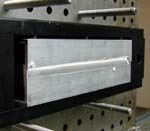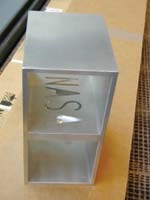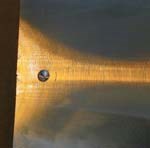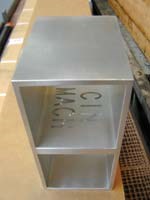Welding On A Machining Center
Multiple-process machine tools generally combine two or more processes for metal removal. A lathe may have milling capability, or a machining center may perform grinding. But what about combining metal removal and metal joining in one machine? A process called 'friction stir welding' permits exactly that.
Multiple-process machine tools generally combine two or more processes for metal removal. A lathe may have milling capability, or a machining center may perform grinding. But what about combining metal removal and metal joining in one machine? A process called "friction stir welding" permits exactly that.
The process uses a solid rotary tool similar to an end mill to allow an existing machining center to be used for welding. The tool plasticizes the metal—there is no melting involved. For Cincinnati Machine's exhibit at the recent International Manufacturing Technology Show in September, the machine tool builder collaborated with NASA on a friction stir welding demonstration. The process looks so similar to an accidental crash on the machine that many who have seen the demo comment that they have been friction stir welding for years and didn't even know it.
The process was developed and patented by TWI, a research organization based in Cambridge, England. Aluminum is the metal most commonly welded this way. NASA uses the process for a very large and critical aluminum structure—the Space Shuttle's aluminum alloy external fuel tank. And while the Shuttle application may be exotic, the process itself is quite simple.
Two parts to be welded are clamped together on the machine work bed. The rotating steel tool penetrates these parts with a pin at the tool's tip. (See photo, facing page.) While the pin is engaged, the tool is fed along the intended weld, plasticizing the metal through frictional heating while forcing the metal to the rear of the tool's path. In the area just behind the pin, the tool's shoulder rubs the material (the tool is held at an angle to ensure this rubbing) to help consolidate. The metal's cooling creates the bond.
Welding in this way actually outperforms conventional fusion welding in a variety of applications. One advantage it offers is very low distortion, even across long welds, making it effective for welding large sheets where flatness is a concern. Another advantage is the ability to join metals that resist conventional welding, such as 7000-series aluminum alloys. With this process, parts made from one of these alloys can be welded instead of riveted, thereby reducing the weight of aircraft assemblies.
Other advantages of friction stir welding relate to the environment immediately surrounding the weld. The process produces neither fumes nor spattering of molten metal.
The lasting evidence of friction stir welding is a divot at the point where the pin exits the work. Workpieces joined through this process may need to be oversize prior to welding, leaving enough extra length so that the small hole can be cut away.
The bond itself rivals the properties of the parent metal in terms of fracture toughness and tensile and bending strength. For one 7000-series aluminum alloy, NASA's Johnson Space Center has developed (patent application in process) a heat treatment able to restore the mechanical properties of the welded alloy. The same heat treatment also reduces the potential for stress corrosion cracking.
Speeds and feed rates for friction stir welding are not aggressive—700 rpm and 6 to 11 ipm are typical parameters. However, the forces involved can be high. The process favors a stiffer, more powerful machine. Also, fixture design can be the most challenging part of this process.
Read Next
3 Mistakes That Cause CNC Programs to Fail
Despite enhancements to manufacturing technology, there are still issues today that can cause programs to fail. These failures can cause lost time, scrapped parts, damaged machines and even injured operators.
Read MoreThe Cut Scene: The Finer Details of Large-Format Machining
Small details and features can have an outsized impact on large parts, such as Barbco’s collapsible utility drill head.
Read More
.jpg;width=70;height=70;mode=crop)












.png;maxWidth=300;quality=90)













